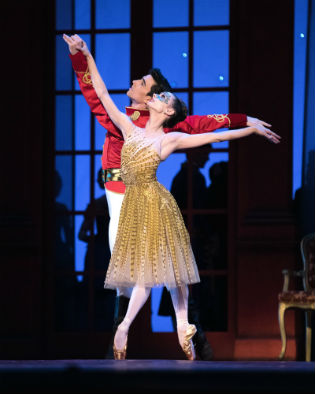Christopher Wheeldon ended up moving to America because he bought a vacuum. While studying at the Royal Ballet School in London, he came across a Hoover promotion that offered free flights to New York for every vacuum purchased. Seizing the opportunity, he was able to join the New York City Ballet, eventually making a name for himself as a choreographer.
Wheeldon's interpretation of Prokofiev's Cinderella, now playing at the Kennedy Center, is rooted in classical ballet but incorporates more obviously emotional movements to appeal to the part of the audience that does not have a background in dance.

Wheeldon has created relatable characters, such as the stepsisters (Sarah Van Patten and Sasha De Sola), who have slapstick fights involving kicking and tripping. Another moment sure to have wide appeal is when the Fates (Daniel Deivison-Oliveira, Francisco Mungamba, Anthony Vincent, and Wei Wang) effortlessly pass Maria Kochetkova's delicate Cinderella through the air in a beautiful nod to the story's fairytale source. A ballerina performing an arabesque is, for all intents and purposes, flying. It is also a high-risk, high-reward move—the risk being that the ballerina may look like she is crowd surfing instead of flying. It is pulled off flawlessly here.
Scenery and costume designer Julian Crouch's work is as important as the choreography, as this same instance shows. Prior to taking flight, Cinderella came out in a light peach-colored dress, a stark contrast to the blue she had been wearing. As she dances with the Fates, four more dancers in dark brown bodysuits emerge carrying plant-covered wheels. The Fates then bring out horse masks as they come together in center stage. Cinderella is lifted as a transparent screen drops between the audience and the dancers. Cinderella’s peach dress billows in the wind as she is swept away to the ball.
Another scene worth commending is the ball itself, which occupies all of the second act. Cinderella emerges in a gold tulle dress, her movements and costume reminiscent of imperial ballet productions like Marius Petipa’s Raymonda. The corps dances in purple, blue, and green before Prince Guillaume, danced by Joseph Walsh, emerges in red and gold. The intensity and beauty of the scene where Walsh and Kochetkova dance alone is fraught with emotion.
Although the third act seems somewhat tacked on to the preceding two, from a structural point of view, this is the perfect ballet for anyone who thinks they don’t like ballet or who wants to start to get to know the art form. The story is well-known and easy to follow, allowing the audience to dip its toes in the water of highly technical and classical ballet.
